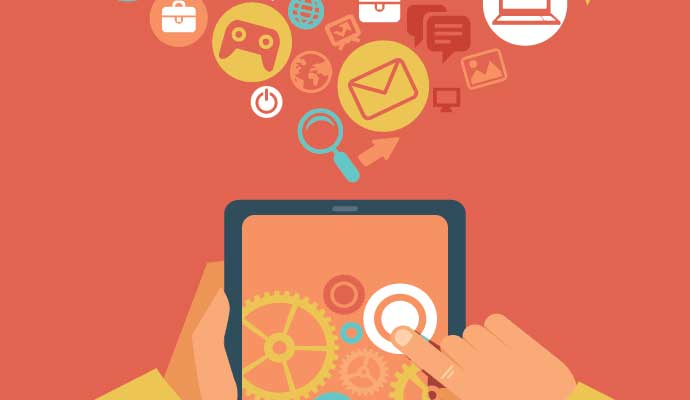Radical Intimacy and the Smartphone
Many companies have not adapted to the deep connection their customers and employees have with their mobile devices.
Humanity has arrived at a technological turning point created by mobile devices, especially smartphones. For the first time, people routinely carry around pocket-sized devices with great computing power. The mobile phone is also one of the most ubiquitous devices in human history — far more popular than the personal computer. As of 2015, about 7 billion people had cell phones (whereas only 4.5 billion had access to indoor plumbing). Of those phones, about 2 billion are smartphones: portable devices with voice and Internet access, touch interfaces, cameras, sensors, and animatable screens. The phones also have downloadable applications that allow people to customize a device and evolve how they make use of it.
Smartphones change interactions between people and organizations, making the connections radically intimate. Because the smartphone is integrated with a person’s physical movement, held in the hand, and often kept next to the heart, it supplants all the other tools people have traditionally used to communicate, gather information, and express themselves. It’s the device through which they get innumerable things done. The more people choose and use their applications, the more the devices become an extension of their owners. Every smartphone is potentially a wormhole between the persona of its owner and the world at large, a visceral connection point, binding people together.
Every smartphone is a wormhole between the persona of its owner and the world at large.
The rise of the smartphone thus raises a fundamental issue involving user experience — an issue that is not just technological, but that concerns the nature of human relationships. Businesses (and other organizations) that can figure out how to adapt to this type of user experience will thrive. Those that cannot will become irrelevant. Tens of thousands of computer applications and the business processes they embody, including thousands used by businesses to connect with their customers and employees, may need to be reengineered for smartphones and tablets, or created for them.
Business has gone through such a change before, when, in the 1970s, 1980s, and 1990s, it reengineered its paper-based information systems for mainframes and then personal computers. That seemed like a major shift at the time. But in retrospect, it was smaller than the change introduced by smartphones. The graphical user interfaces of Macintosh and Windows computers, with their text-heavy look and feel and typewriter-like keyboard input, were designed to evoke paper. People shuffled windows on those computers as they had once shuffled paper documents. The computer system was simply a way to maximize the output of people working at desks.
The smartphone and tablet, by contrast, are creating a new way of interacting with and through machines. These devices are, as everyone knows, essentially computers. But they are no longer relegated to a desk or an office. Interacting with the old devices is like playing a piano; each key is a discrete input normally pressed separately. Interacting with a smartphone or tablet involves a much wider range of continuous motion. Like molding clay with your hands, it gives you a more visceral, free-form connection to what you’re doing.
For years, businesses have tried to use digital technology for strategic advantage. They automate just about everything they do, but they find themselves unable to gain the productivity they should. The reason is right in front of them — or, rather, right in front of the people who are forced to use their internal systems. Most businesses invest very little in appropriately addressing their software user experiences, and all but a few of their systems provide a terrible user experience.
The smartphone will, at long last, force businesses to change. Most businesses have let smartphones and tablets become gateways to their systems. They do this because workers who are comfortable with, and proficient at, their tools make fewer mistakes and are more productive. Employees, for their part, naturally expect to use smartphones at work, because the devices are so closely connected to the rest of their lives. It seems silly not to do things at work the same way they do things elsewhere.
But when businesses let people use their mobile devices, these extensions of the self, a new orientation is required. The institution has decidedly less control over its information, or the time and place of using it, because of the personal nature of the connection. The workforce also has a new, richer form of expression, in both providing information and collecting it, and business applications need to adapt.
Freedom from the Form
To realize the depth of this change, consider something that most people take for granted. The form, a document in which people record data from the field, is at least as old as the Old Testament. In Chapter 13 of the book of Numbers, Moses sends 12 spies to scout ahead and gather information about the land of Canaan, and he gives them the equivalent of fields to fill in and boxes to check, telling them to report on “the land, what it is like; and the population that is settled in it: are they strong or weak, are they few or many; and what the land is like, where are they settled: is it good or ill; and what the towns are like, where they are settled therein: are they encampments or fortified-places; and what the land is like: is it fat or lean, are there in it trees, or not?” (This passage is from the The Schocken Bible, Vol. 1: The Five Books of Moses, transl. by Everett Fox.)
Companies make similar requests today of the field representatives they send to take inventory of store shelves. To be sure, instead of parchment or paper, the form is now on an electronic tablet, a device that can take photographs, record and play audio and video, and manage many other forms of media. Yet in gathering information, most people still use the form on a tablet as though it were paper on a clipboard. The doctor seeking data during surgery or the building inspector looking at a boiler must turn away from the task at hand and look down at the screen, to check for information or enter data, just as on paper. This is not only an inconvenience, it is a possible danger, because people are prone to errors. Interrupting the flow of what they are doing, and requiring them to fill in data as they would on paper, or with a keyboard, increases their chances of making a mistake, especially over time.
The smartphone is qualitatively different than a tablet. It provides freedom from the form. It enables a new approach to human–device interaction: an approach that doesn’t mimic an individual sitting at a desk with a piece of paper, doing a task.
For example, a real estate app called MagicPlan uses the motion-detection and photographic capabilities of the smartphone to capture the dimensions and features of its environment. You can point a phone or tablet toward the corners, doors, windows, furnishings, and other features of the room and it will draw a floor plan for you. There are apps for physicians that display customized images of the human body, making it easier to talk to patients about their situation, and other apps that measure patient indicators such as heart and respiratory rates, without requiring the medical professional to look away. There are apps for fixing boilers, which allow building inspectors and engineers to more easily recognize problems without having to look up the technical specs. And, of course, there are a wide range of GPS-based navigation apps, which must be simple enough for drivers to use safely.
The Once and Future Business Response
All these apps, and many more like them, are beginning to change the way businesses connect with their employees. The apps transcend the limitations of the paper form. They gather information automatically, or through gestures, voices, and photographs, and then they translate it into data that is easy to manipulate and retrieve.
Smartphone apps depend on having a user experience that people find natural and comfortable. (That may not, by the way, mean easy to learn, if learning the app is part of learning the job.) As a result, the rise of smartphones has brought much-needed attention to the question of user experience.
As a software developer, I know that information technology professionals often think they are making work better simply because they’re computerizing it. When we think that, we are wrong. We rarely even try to track the fatigue, friction, and loss of commitment that stems from poorly designed technology. And poorly designed technology is everywhere.
“When the inventor of the USB stick dies,” wrote the Twitter comedian Cluedont, “they’ll gently lower the coffin, then pull it back up, turn it the other way, then lower it again.” The time spent figuring out the right way to insert a USB stick may not seem like much, but the distraction is real. If someone has to call customer service because the buttons on the computer interface all look the same, that’s more lost time. If a doctor won’t use a patient records system because it’s too hard to figure out or too cumbersome and error-prone to use, that’s even worse. All these things add up. You can’t measure the productivity and quality that you would have gained if things were better. So every company loses the time, trust, and benefits of the skills of its employees, while assuming that it is winning.
As smartphones become the primary computer in employees’ lives, companies will have to apply design thinking — a focus on people, how they work, and how they use tools — to their interfaces. The process of creating internal systems will change, incorporating great amounts of feedback from customers, potential customers, workers, and potential workers. Businesses will gain radical intimacy, a close connection with the people who buy from them and work for them.
As smartphones become the primary computer in employees’ lives, companies will have to apply design thinking to their interfaces.
To be sure, radical intimacy presents certain problems for business. Most people, as a rule, don’t want to be intimate with companies, especially those they work for. A purely transactional relationship has many benefits for the individual, including the expectation that he or she could negotiate a better deal, and leave if it falls through. Moreover, the senior decision makers in most companies don’t want radical intimacy either. They have thousands of employees, and they believe that close relationships will require an untenable amount of time and attention. Blindly emulating the social world is inappropriate.
But mobile devices will force businesses to overcome these obstacles. They can start by improving their user interfaces. User interface is the touch point for human relationships and behavior, the connection point between the person and the organization. At first glance, it may seem like a minor thing to focus on, even inconsequential — but it is actually profound.
Author profile:
- Dan Bricklin is the chief technology officer of Alpha Software Corporation and president of Software Garden. He is the co-creator of VisiCalc, the pioneering electronic spreadsheet released in 1979. His other innovations include the prototyping tool Dan Bricklin’s Demo Program (1985), the website creation tool Trellix (late 1990s), and the handwriting capture app Note Taker HD for the iPad (2010).





